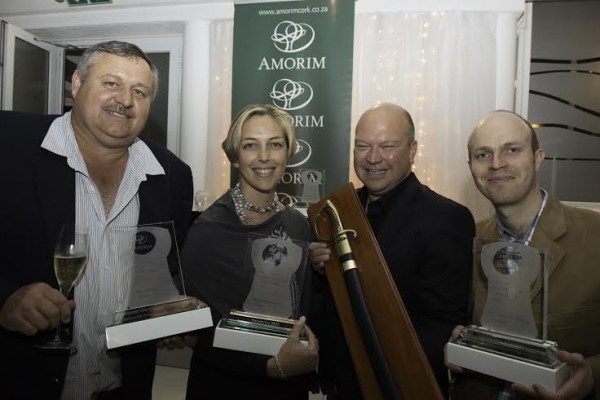The Durbanville Wine Region’s Altydgedacht Estate, one of the oldest wine estates in South Africa, was crowned South Africa’s top Cap Classique exponent at this year’s Amorim Cap Classique Challenge. The Altydgedacht MCC 2013, made exclusively from Chardonnay grapes, not only took the Trophy for the competition’s Best Blanc de Blancs, but was also crowned as the overall winner for 2015 having achieved the top score from all 114 entries received, the most in the competition’s history.
Top Image Caption:
The four Trophy winners at this year’s Amorim Cap Classique Challenge:From left: Simon Smith (Louisvale), Elunda Basson (Pongrácz), Etienne Louw (Altydgedacht) and Johann Fourie (KWV).
The only competition committed exclusively to the Cap Classique category, the Amorim Cap Classique Challenge is sponsored by Portugal-based cork company Amorim. This was the 14th year South Africa’s producers of bottle-fermented sparkling wine took part in this premier wine event, which was held at the 12 Apostles Hotel and Spa on the eve of Cape Wine 2015.
This year’s Cap Classique Challenge saw a change in judging procedures in that categories were narrowed, with judging no longer being done separately on vintage and non-vintage wines. Cap Classiques were judged in the following categories: Blanc de Blancs, Rosé, Blended Brut and a Museum Class for wines including and before the 2008 vintage. To promote inclusivity among producers, entries were open to non-members of the Cap Classique Producers Association.
Louisvale Wines from Stellenbosch took the Trophy for Best Rosé with the Louisvale Chardonnay/Pinot Noir Rosé n/v, while KWV – no stranger to Cap Classique Trophies, won Best Blended Brut for the 2010 Laborie MCC Brut, made from Chardonnay and Pinot Noir.
The Trophy for Best Museum Class Cap Classique, always an eagerly awaited award, went to Desiderius 2003, an icon wine of Distell’s Pongrácz label which is a blend of Chardonnay and Pinot Noir.
Chairman of the judging panel Allan Mullins said that this year’s wines were remarkably consistent.
“The good side of this is that there were less faulty wines or poor wines than last year but the downside is that although there were far less bad wines than last year, it was difficult to identify standout wines with the ‘wow’ factor,” he says.
To explain this the panel felt that due to the upswing in demand many MCCs were not being given enough maturation time on the lees as well as being rushed to market without sufficient time in the bottle.
“There were only four wines in the Museum class with three of them showing exceptionally well. There is no doubt that quality Cap Classiques improve with age and it is surprising and unfortunate that more producers are not holding back some of their better wines to impress and sell to consumers as well as entering this challenge.
“In previous years there were a significant number of green, unripe wines, wines with an excess of aldehyde and wines showing over-oaking of the base wines. This was not the case this year and many of the new producers performed well. This points to growers selecting vineyards more suited to Cap Classique production and winemakers learning from the ‘old hands’”
Antonio Amorim, President of Amorim Cork based in Santa Maria de Lamas in northern Portugal, said the South Africa’s wine industry can feel justifiably proud of its Cap Classique category.
“As a cork producer, Amorim believes that a natural cork adds value to a bottle of wine by endorsing the product with a closure that represents tradition and quality. This is what Cap Classique does for the South African wine industry: it adds value,” said Amorim.
“To have a sector of diverse and expressive Cap Classique sparkling wines to add to the exciting offerings of the South African wine category is indeed a privilege. Cap Classique is vibrant, it appeals to all wine lovers and the number of exciting producers making this product of exceptional quality is something the whole wine industry should be immensely proud of.
“The quality of product and the excitement of the category complement the image of the South African wine industry, and here we have to thank the pioneers who created Cap Classique over 40 years ago as well as the passionate and headstrong pursuers of excellence who built the category to what it is today. As a partner of the global wine industry, Amorim is immensely proud to be associated with the product and its people who add value to the lovely everyday pleasure that is wine.”
Amorim also said that the Cap Classique industry can have a bright future on export markets.
“The current global popularity of sparkling wines outside of Champagne, which includes Spanish Cava and Italian Prosecco, shows there is a thirst for bubbles that international producers are struggling to sate,” he said. “Cape Classique can command a place in this arena through sheer quality in terms of vineyard expression and skilled winemaking. Amorim looks forward to being part of this bright future.”
This year’s Amorim Cap Classique Challenge was judged by Mullins, writers Cathy Marston and Samarie Smith, sommelier and wine exporter David Clarke and critic Christian Eedes. Pearl Oliver, sommelier at the Belmond Mt Nelson Hotel, was an associate judge.




